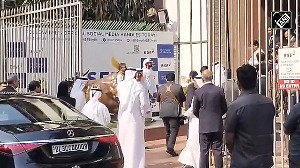The mainstay of Finance Minister Jaswant Singh's Budget for 2003-04 was a Rs 60,000 crore (Rs 600 billion) infrastructure spending plan aimed at stimulating industrial recovery.
Singh had said roads, railways, airports and ports would be developed through innovative funding based on public-private partnership.
Till the end of May, no firm investment plan was in place.
There were only some discussions on the new concept of 'viability gap' funding-- in which the government will bridge the gap between a project's internal rate of return and the actual return.
Towards the end of June, Singh decided to constitute an internal task force under finance secretary D C Gupta to expedite action on the plan.
Whatever movement there has been on this plan has largely been limited to roads.
The ministry of road transport and highways has appointed consultants for preparing detailed project reports for seven of the 48 projects announced in Budget.
The cost of the 48 projects has been estimated at Rs 40,000 crore (Rs 400 billion).
Financial bids are expected once the consultants submit their detailed project reports.
Work on the seven projects will, hopefully, commence during the second half of the current fiscal. A part of the Rs 2,000 crore (Rs 20 billion) earmarked by the finance ministry for viability gap funding would be utilised on roads, senior government officials said.
Meanwhile, the railway ministry has also appointed a steering committee to look at specific expansion projects.
Moreover, the finance ministry has decided on an equity contribution of Rs 500 crore (Rs 5 billion) to the Rail Vikas Nigam Ltd (RVNL), the company proposed to be set up by the railway ministry to implement the Rs 8,000 crore (Rs 80 billion) National Rail Vikas Yojana.
Besides working on the Railways' Golden Quadrilateral project aimed at connecting the four metros, RVNL will also work on building bridges over the Ganga and the Bramhaputra rivers.
Officials said the Rs 500 crore (Rs 5 billion) equity contribution to RVNL was part of the Rs 2,000 crore (Rs 20 billion) viability gap fund.
The civil aviation ministry, after some initial hiccups, is ready with its proposals for the upgradation of the Delhi and Mumbai airports and will take them to the Cabinet soon.
On the insistence of the finance ministry, the civil aviation ministry decided to involve prospective bidders for the airport projects from the conceptualisation stage.
The ministry had initially asked global architects and consultants to submit bids for designing the two airports, which are to be constructed by private companies.
The cost of the entire project, estimated at Rs 3,500 crore (Rs 35 billion), will be fully tied up by private developers.
Little headway has been made into the development of ports. Though Singh had announced a Rs 7,500 crore (Rs 75 billion) renovation plan for two ports, the shipping and finance ministries are yet to hold discussions on it.
Singh had also proposed the setting up of two global convention centres at a cost of Rs 1,000 crore (Rs 10 billion). The finance ministry plans to rope in the ministry of tourism to float global bids for building these centres.
With several states showing interest, the finance ministry now intends to build more than two centres.
The evaluation of bids will be based on minimum viability gap funding as demanded by private developers. Work is expected to start on at least one convention centre in the current fiscal.






 © 2025
© 2025